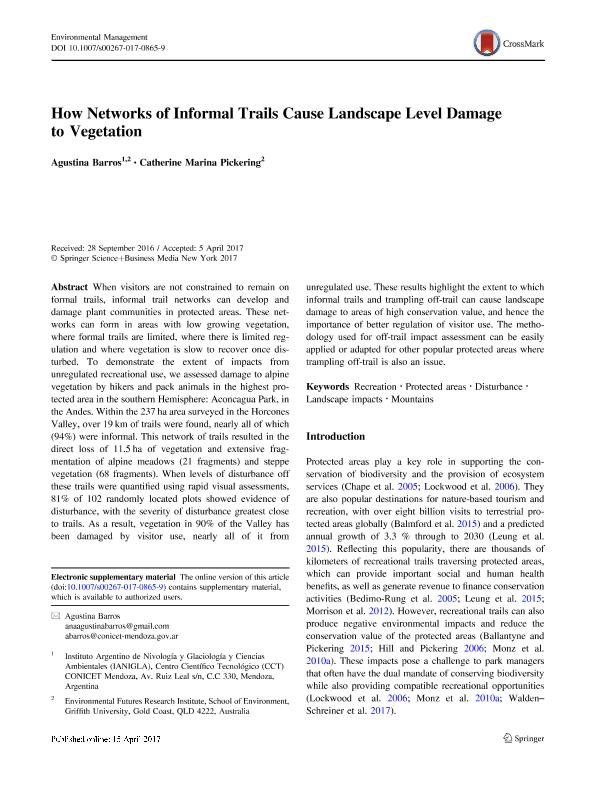Artículo
How Networks of Informal Trails Cause Landscape Level Damage to Vegetation
Fecha de publicación:
07/2017
Editorial:
Springer
Revista:
Environmental Management
ISSN:
0364-152X
Idioma:
Inglés
Tipo de recurso:
Artículo publicado
Clasificación temática:
Resumen
When visitors are not constrained to remain on formal trails, informal trail networks can develop and damage plant communities in protected areas. These networks can form in areas with low growing vegetation, where formal trails are limited, where there is limited regulation and where vegetation is slow to recover once disturbed. To demonstrate the extent of impacts from unregulated recreational use, we assessed damage to alpine vegetation by hikers and pack animals in the highest protected area in the southern Hemisphere: Aconcagua Park, in the Andes. Within the 237 ha area surveyed in the Horcones Valley, over 19 km of trails were found, nearly all of which (94%) were informal. This network of trails resulted in the direct loss of 11.5 ha of vegetation and extensive fragmentation of alpine meadows (21 fragments) and steppe vegetation (68 fragments). When levels of disturbance off these trails were quantified using rapid visual assessments, 81% of 102 randomly located plots showed evidence of disturbance, with the severity of disturbance greatest close to trails. As a result, vegetation in 90% of the Valley has been damaged by visitor use, nearly all of it from unregulated use. These results highlight the extent to which informal trails and trampling off-trail can cause landscape damage to areas of high conservation value, and hence the importance of better regulation of visitor use. The methodology used for off-trail impact assessment can be easily applied or adapted for other popular protected areas where trampling off-trail is also an issue.
Palabras clave:
Disturbance
,
Landscape Impacts
,
Mountains
,
Protected Areas
,
Recreation
Archivos asociados
Licencia
Identificadores
Colecciones
Articulos(IANIGLA)
Articulos de INST. ARG. DE NIVOLOGIA, GLACIOLOGIA Y CS. AMBIENT
Articulos de INST. ARG. DE NIVOLOGIA, GLACIOLOGIA Y CS. AMBIENT
Citación
Barros, Ana Agustina; Pickering, Catherine Marina; How Networks of Informal Trails Cause Landscape Level Damage to Vegetation; Springer; Environmental Management; 60; 1; 7-2017; 57-68
Compartir
Altmétricas




